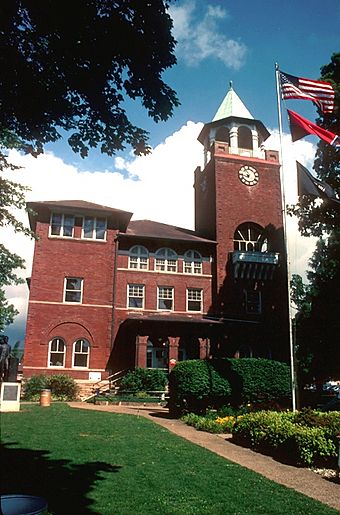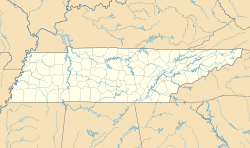Rhea County Courthouse facts for kids
|
Rhea County Courthouse
|
|

The Rhea County Courthouse
|
|
| Location | 1475 Market Street Dayton, Tennessee |
|---|---|
| Area | 3.7 acres (1.5 ha) |
| Built | 1891 |
| Architect | W. Chamberlin Dowling & Taylor |
| Architectural style | Italian villa Romanesque |
| NRHP reference No. | 72001251 |
Quick facts for kids Significant dates |
|
| Added to NRHP | November 7, 1972 |
| Designated NHL | December 8, 1976 |
The Rhea County Courthouse is a historic building in Dayton, Tennessee. It was built in 1891. This courthouse is famous because of the Scopes trial that happened there in July 1925.
During this trial, a teacher named John T. Scopes was accused of teaching Charles Darwin's theory of evolution. At that time, a state law made it illegal to teach evolution in public schools. The trial became a big debate between two famous lawyers: William Jennings Bryan for the prosecution (the side bringing the charges) and Clarence Darrow for the defense (Scopes's side). This event showed the tension between traditional beliefs and newer ideas in American society.
Today, the courthouse also has a museum about the trial. It was recognized as a National Historic Landmark in 1976.
Contents
What the Courthouse Looks Like
The Rhea County Courthouse stands in the middle of Dayton. It is a three-story building made of brick. It has features from both Romanesque and Italianate styles of architecture. The building has a wide, sloped roof. There is a shorter tower at one corner and a taller square tower with a clock and an open bell area on the other side. Some windows are shaped with round arches at the top. Inside, many parts of the building are still original. This includes the main courtroom on the second floor, where the famous Scopes trial took place.
The Courthouse's History
The courthouse was built between 1890 and 1891. This happened after Dayton became the county seat, taking over from Washington. Architects from Knoxville, Tennessee designed the building. Contractors from Chattanooga, Tennessee built it.
In July 1925, the courthouse became the site of the Scopes trial. This trial was one of the most talked-about events of the 1920s. Local people helped set up the trial as a way to get attention for Dayton. This happened after Tennessee passed the Butler Act, which made it illegal to teach biological evolution in public schools. John T. Scopes, a science teacher, was arrested and charged with breaking this law.
The state's side was represented by William Jennings Bryan. He was a well-known speaker and a strong supporter of traditional Christian beliefs. Scopes was defended by a team funded by the ACLU. This team was led by the famous criminal defense lawyer Clarence Darrow. Even though Scopes was found guilty, the trial created a huge public discussion. It highlighted the differences between legal ideas, as well as between traditional beliefs and modern thinking. The defense team even called Bryan to the stand to question his views. In the years that followed, many states that had similar laws eventually removed them.
Rhea County Museum: The Scopes Trial Story
In 1979, a project costing $1 million was finished. This project restored the second-floor courtroom to look exactly as it did during the Scopes trial. The Rhea County Museum, also known as the Scopes Trial Museum, is located in the courthouse basement. It holds many items from the trial. These include the microphone used to broadcast the trial, official trial records, photographs, and a video history of the event. Every July, local people act out important moments from the trial in the courtroom.
Outside the courthouse, there is a special plaque put up by the Tennessee Historical Commission. It reads:
2B 23
THE SCOPES TRIALHere, from July 10 to 21, 1925, John
Thomas Scopes, a county high school
teacher, was tried for teaching that
a man descended from a lower order
of animals in violation of a lately
passed state law. William Jennings
Bryan assisted the prosecution;
Clarence Darrow, Arthur Garfield
Hays, and Dudley Field Malone the
defense. Scopes was convicted.
The Rhea County Courthouse was named a National Historic Landmark by the National Park Service in 1976. It was also added to the National Register of Historic Places in 1972.
On October 1, 2005, a statue of William Jennings Bryan was placed on the courthouse lawn. This statue was paid for by a donation from nearby Bryan College. It was put there to celebrate the school's 75th anniversary.
On July 14, 2017, a statue of Clarence Darrow was revealed near Bryan's statue. This statue was funded by a donation from the Freedom From Religion Foundation.
See also



